Abstract
Five alternative methods were used to explore in vitro the effects of normal and activated murine macrophages on the metabolic well-being of intracellular Mycobacterium leprae: fluorescein diacetate-ethidium bromide staining, ATP content, synthesis of phenolic glycolipid 1, and two techniques to quantitate oxidation of palmitic acid. In relatively short-term experiments (7 to 10 days), each of these procedures provided strong evidence that activated macrophages exerted a deleterious effect on the leprosy bacillus. These findings appear to confirm the contention that activated macrophages underlie host resistance to clinical leprosy and limitation of M. leprae growth in paucibacillary leprosy.
Full text
PDF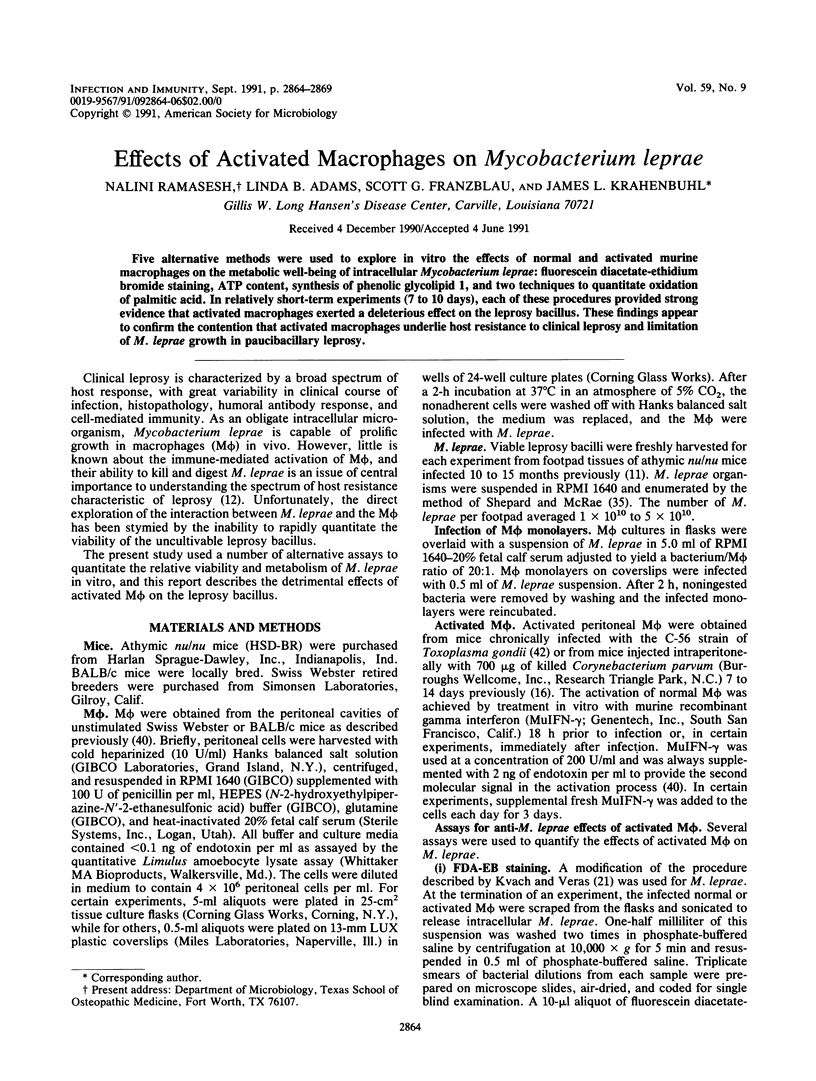
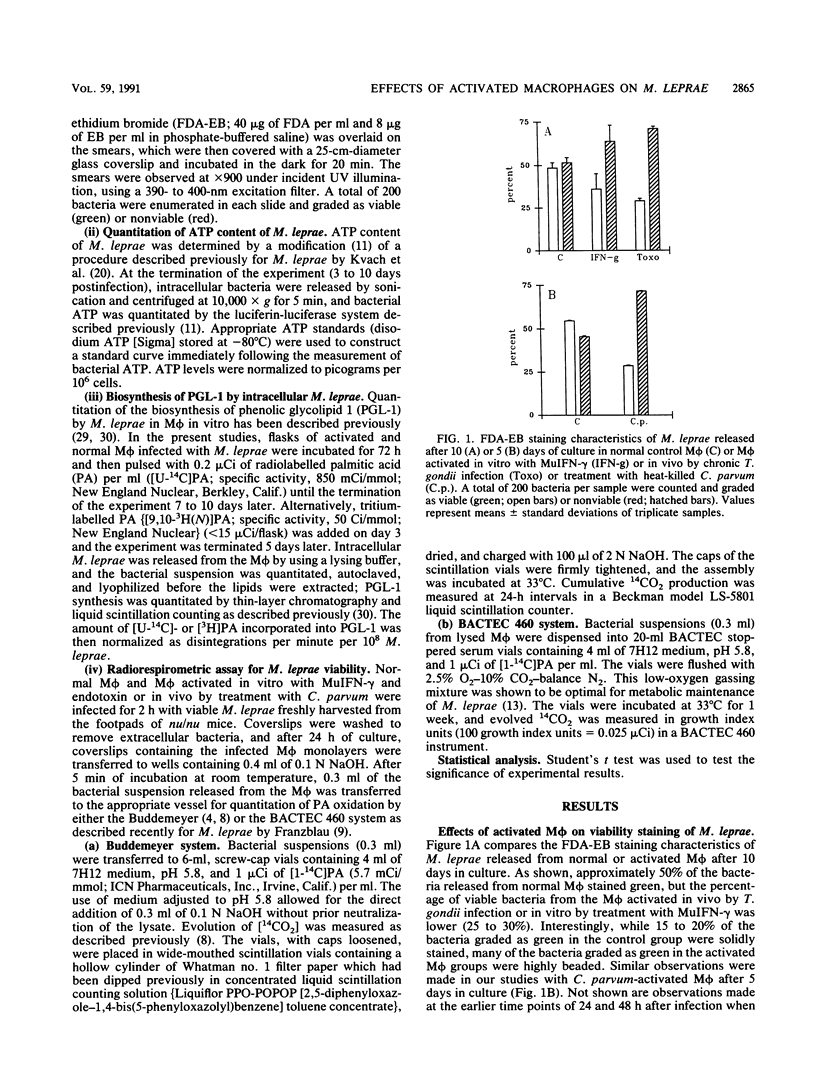
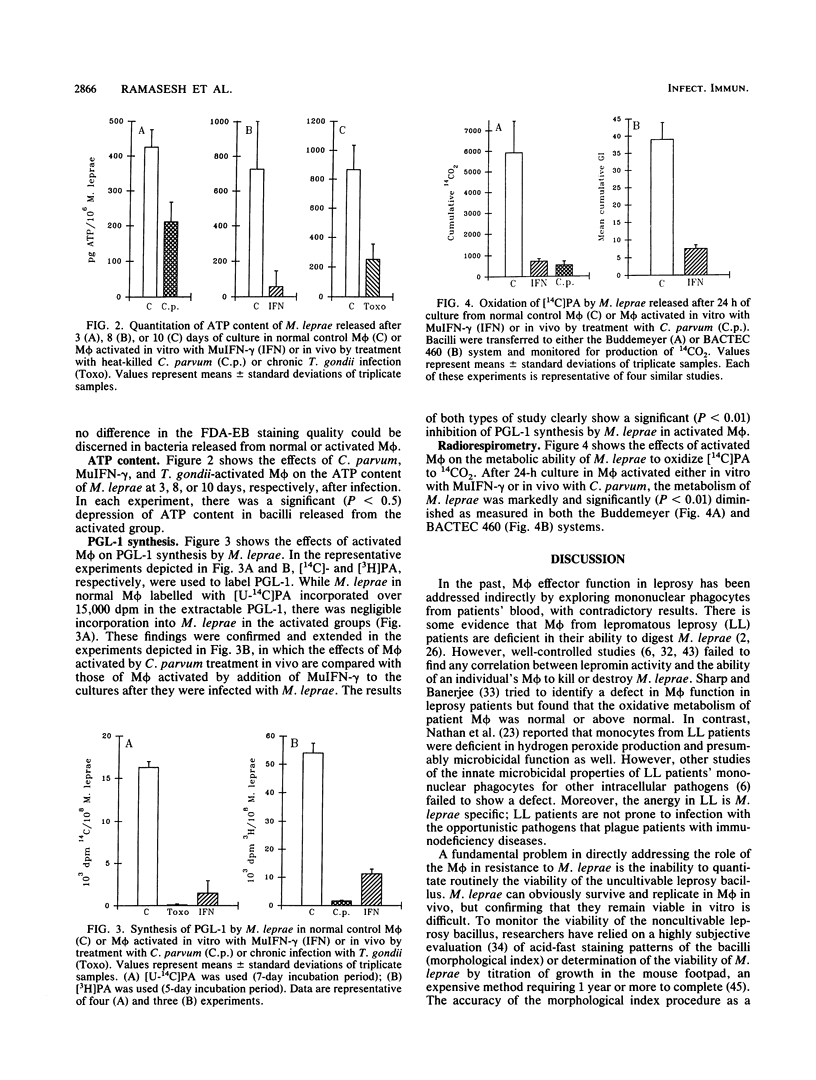
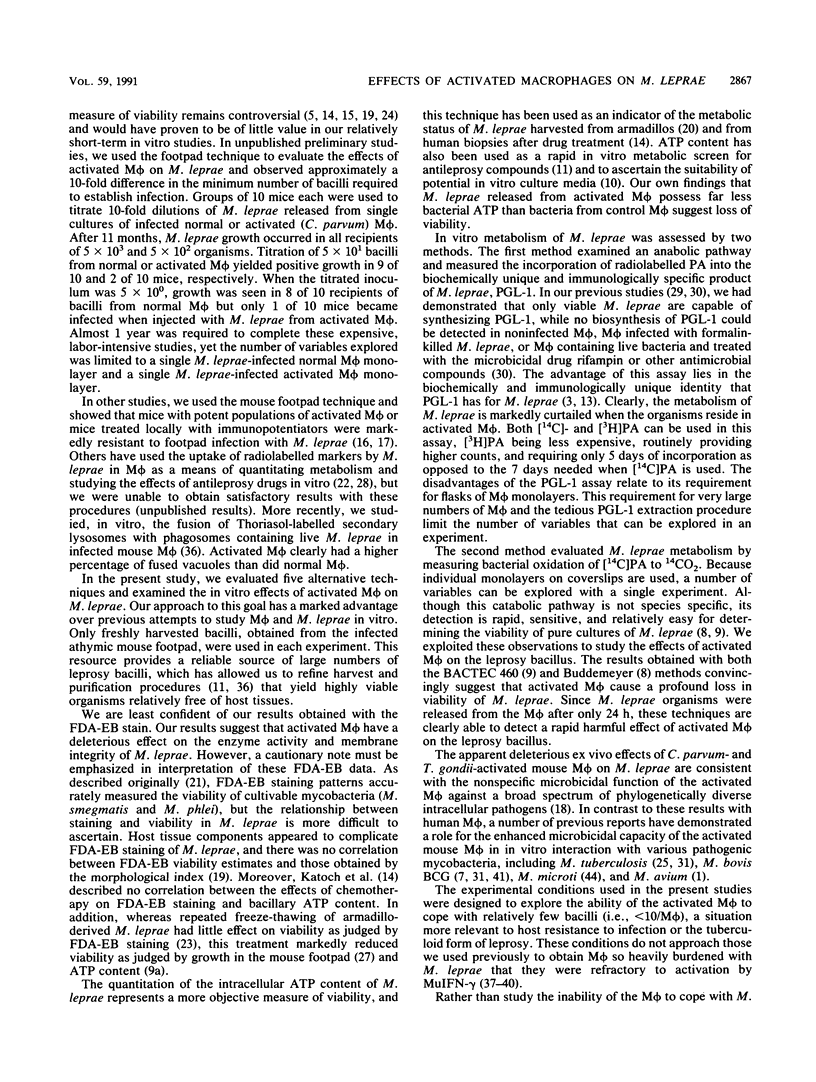

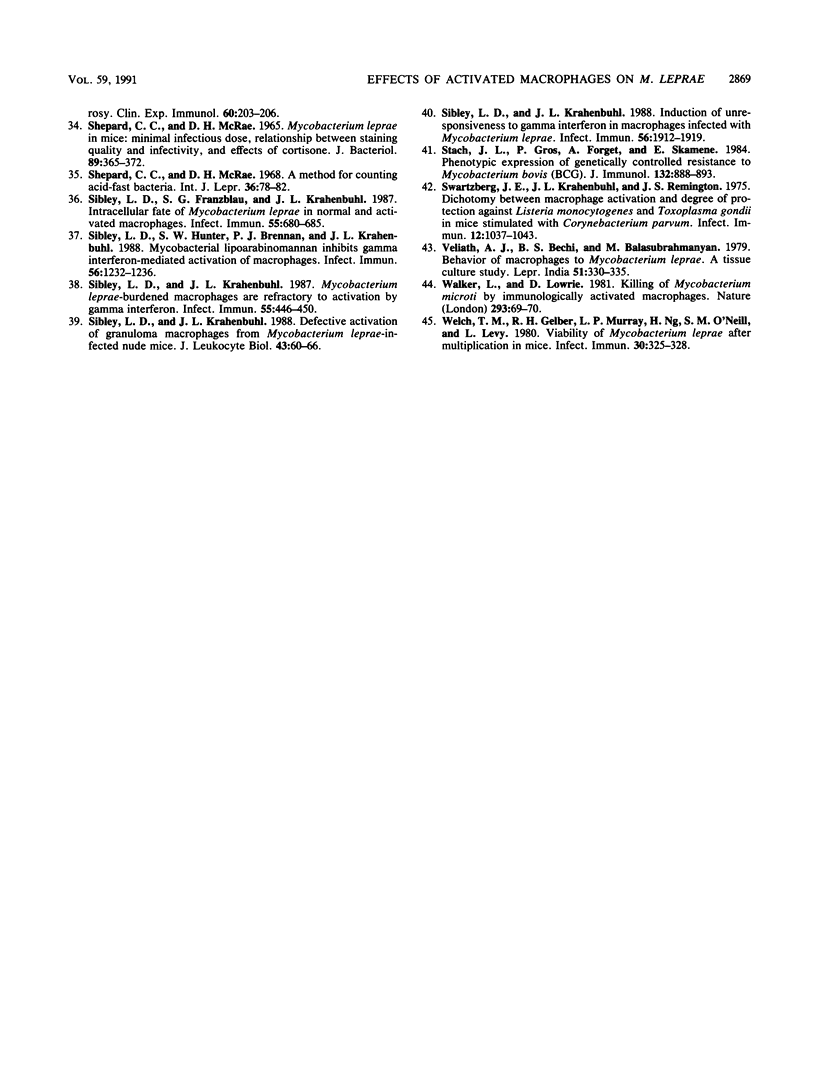
Selected References
These references are in PubMed. This may not be the complete list of references from this article.
- Beiguelman B. Leprosy and genetics. A review of past research with remarks concerning future investigations. Bull World Health Organ. 1967;37(3):461–476. [PMC free article] [PubMed] [Google Scholar]
- Brennan P. J., Barrow W. W. Evidence for species-specific lipid antigens in Mycobacterium leprae. Int J Lepr Other Mycobact Dis. 1980 Dec;48(4):382–387. [PubMed] [Google Scholar]
- Desikan K. V. Correlation of morphology with viability of Mycobacterium leprae. Lepr India. 1976 Oct;48(4):391–397. [PubMed] [Google Scholar]
- Drutz D. J., Cline M. J., Levy L. Leukocyte antimicrobial function in patients with leprosy. J Clin Invest. 1974 Feb;53(2):380–386. doi: 10.1172/JCI107570. [DOI] [PMC free article] [PubMed] [Google Scholar]
- Flesch I., Kaufmann S. H. Mycobacterial growth inhibition by interferon-gamma-activated bone marrow macrophages and differential susceptibility among strains of Mycobacterium tuberculosis. J Immunol. 1987 Jun 15;138(12):4408–4413. [PubMed] [Google Scholar]
- Franzblau S. G. Drug susceptibility testing of Mycobacterium leprae in the BACTEC 460 system. Antimicrob Agents Chemother. 1989 Dec;33(12):2115–2117. doi: 10.1128/aac.33.12.2115. [DOI] [PMC free article] [PubMed] [Google Scholar]
- Franzblau S. G., Harris E. B. Biophysical optima for metabolism of Mycobacterium leprae. J Clin Microbiol. 1988 Jun;26(6):1124–1129. doi: 10.1128/jcm.26.6.1124-1129.1988. [DOI] [PMC free article] [PubMed] [Google Scholar]
- Franzblau S. G., Hastings R. C. Rapid in vitro metabolic screen for antileprosy compounds. Antimicrob Agents Chemother. 1987 May;31(5):780–783. doi: 10.1128/aac.31.5.780. [DOI] [PMC free article] [PubMed] [Google Scholar]
- Franzblau S. G. Oxidation of palmitic acid by Mycobacterium leprae in an axenic medium. J Clin Microbiol. 1988 Jan;26(1):18–21. doi: 10.1128/jcm.26.1.18-21.1988. [DOI] [PMC free article] [PubMed] [Google Scholar]
- Hastings R. C., Gillis T. P., Krahenbuhl J. L., Franzblau S. G. Leprosy. Clin Microbiol Rev. 1988 Jul;1(3):330–348. doi: 10.1128/cmr.1.3.330. [DOI] [PMC free article] [PubMed] [Google Scholar]
- Hunter S. W., Brennan P. J. A novel phenolic glycolipid from Mycobacterium leprae possibly involved in immunogenicity and pathogenicity. J Bacteriol. 1981 Sep;147(3):728–735. doi: 10.1128/jb.147.3.728-735.1981. [DOI] [PMC free article] [PubMed] [Google Scholar]
- Katoch V. M., Katoch K., Ramanathan U., Sharma V. D., Shivannavar C. T., Datta A. K., Bharadwaj V. P. Effect of chemotherapy on viability of Mycobacterium leprae as determined by ATP content, morphological index and FDA-EB fluorescent staining. Int J Lepr Other Mycobact Dis. 1989 Sep;57(3):615–621. [PubMed] [Google Scholar]
- Katoch V. M., Katoch K., Ramu G., Sharma V. D., Datta A. K., Shivannavar C. T., Desikan K. V. In vitro methods for determination of viability of mycobacteria: comparison of ATP content, morphological index and FDA-EB fluorescent staining in Mycobacterium leprae. Lepr Rev. 1988 Jun;59(2):137–143. doi: 10.5935/0305-7518.19880018. [DOI] [PubMed] [Google Scholar]
- Krahenbuhl J. L., Humphres R. C., Henika P. C. Effects of Propionibacterium acnes treatment on the course of Mycobacterium leprae infection in mice. Infect Immun. 1982 Jul;37(1):183–188. doi: 10.1128/iai.37.1.183-188.1982. [DOI] [PMC free article] [PubMed] [Google Scholar]
- Krahenbuhl J. L., Levy L., Remington J. S. Resistance to Mycobacterium leprae in Mice Infected with Toxoplasma gondii and Besnoitia jellisoni. Infect Immun. 1974 Nov;10(5):1068–1071. doi: 10.1128/iai.10.5.1068-1071.1974. [DOI] [PMC free article] [PubMed] [Google Scholar]
- Kvach J. T., Munguia G., Strand S. H. Staining tissue-derived Mycobacterium leprae with fluorescein diacetate and ethidium bromide. Int J Lepr Other Mycobact Dis. 1984 Jun;52(2):176–182. [PubMed] [Google Scholar]
- Kvach J. T., Neubert T. A., Palomino J. C., Heine H. S. Adenosine triphosphate content of Mycobacterium leprae isolated from armadillo tissue by Percoll buoyant density centrifugation. Int J Lepr Other Mycobact Dis. 1986 Mar;54(1):1–10. [PubMed] [Google Scholar]
- Kvach J. T., Veras J. R. A fluorescent staining procedure for determining the viability of mycobacterial cells. Int J Lepr Other Mycobact Dis. 1982 Jun;50(2):183–192. [PubMed] [Google Scholar]
- Mittal A., Sathish M., Seshadri P. S., Nath I. Rapid, radiolabeled-microculture method that uses macrophages for in vitro evaluation of Mycobacterium leprae viability and drug susceptibility. J Clin Microbiol. 1983 Apr;17(4):704–707. doi: 10.1128/jcm.17.4.704-707.1983. [DOI] [PMC free article] [PubMed] [Google Scholar]
- Nathan C. F., Kaplan G., Levis W. R., Nusrat A., Witmer M. D., Sherwin S. A., Job C. K., Horowitz C. R., Steinman R. M., Cohn Z. A. Local and systemic effects of intradermal recombinant interferon-gamma in patients with lepromatous leprosy. N Engl J Med. 1986 Jul 3;315(1):6–15. doi: 10.1056/NEJM198607033150102. [DOI] [PubMed] [Google Scholar]
- Odinsen O., Nilson T., Humber D. P. Viability of Mycobacterium leprae: a comparison of morphological index and fluorescent staining techniques in slit-skin smears and M. leprae suspensions. Int J Lepr Other Mycobact Dis. 1986 Sep;54(3):403–408. [PubMed] [Google Scholar]
- Patterson R. J., Youmans G. P. Demonstration in tissue culture of lymphocyte-mediated immunity to tuberculosis. Infect Immun. 1970 Jun;1(6):600–603. doi: 10.1128/iai.1.6.600-603.1970. [DOI] [PMC free article] [PubMed] [Google Scholar]
- Pisani R. C., Beiguelman B., Opromolla D. V. In vitro behavior of blood derived macrophages against killed M. leprae. Int J Lepr Other Mycobact Dis. 1973 Jan-Mar;41(1):14–24. [PubMed] [Google Scholar]
- Portaels F., Fissette K., De Ridder K., Macedo P. M., De Muynck A., Silva M. T. Effects of freezing and thawing on the viability and the ultrastructure of in vivo grown mycobacteria. Int J Lepr Other Mycobact Dis. 1988 Dec;56(4):580–587. [PubMed] [Google Scholar]
- Prasad H. K., Hastings R. C. Alternate radiolabeled markers for detecting metabolic activity of Mycobacterium leprae residing in murine macrophages. J Clin Microbiol. 1985 May;21(5):861–864. doi: 10.1128/jcm.21.5.861-864.1985. [DOI] [PMC free article] [PubMed] [Google Scholar]
- Ramasesh N., Hastings R. C., Krahenbuhl J. L. Metabolism of Mycobacterium leprae in macrophages. Infect Immun. 1987 May;55(5):1203–1206. doi: 10.1128/iai.55.5.1203-1206.1987. [DOI] [PMC free article] [PubMed] [Google Scholar]
- Ramasesh N., Krahenbuhl J. L., Hastings R. C. In vitro effects of antimicrobial agents on Mycobacterium leprae in mouse peritoneal macrophages. Antimicrob Agents Chemother. 1989 May;33(5):657–662. doi: 10.1128/aac.33.5.657. [DOI] [PMC free article] [PubMed] [Google Scholar]
- Rook G. A., Steele J., Ainsworth M., Champion B. R. Activation of macrophages to inhibit proliferation of Mycobacterium tuberculosis: comparison of the effects of recombinant gamma-interferon on human monocytes and murine peritoneal macrophages. Immunology. 1986 Nov;59(3):333–338. [PMC free article] [PubMed] [Google Scholar]
- SHEPARD C. C., MCRAE D. H. MYCOBACTERIUM LEPRAE IN MICE: MINIMAL INFECTIOUS DOSE, RELATIONSHIP BETWEEN STAINING QUALITY AND INFECTIVITY, AND EFFECT OF CORTISONE. J Bacteriol. 1965 Feb;89:365–372. doi: 10.1128/jb.89.2.365-372.1965. [DOI] [PMC free article] [PubMed] [Google Scholar]
- Samuel D. R., Godal T., Myrvang B., Song Y. K. Behavior of Mycobacterium leprae in human macrophages in vitro. Infect Immun. 1973 Sep;8(3):446–449. doi: 10.1128/iai.8.3.446-449.1973. [DOI] [PMC free article] [PubMed] [Google Scholar]
- Sharp A. K., Banerjee D. K. Hydrogen peroxide and superoxide production by peripheral blood monocytes in leprosy. Clin Exp Immunol. 1985 Apr;60(1):203–206. [PMC free article] [PubMed] [Google Scholar]
- Shepard C. C., McRae D. H. A method for counting acid-fast bacteria. Int J Lepr Other Mycobact Dis. 1968 Jan-Mar;36(1):78–82. [PubMed] [Google Scholar]
- Sibley L. D., Franzblau S. G., Krahenbuhl J. L. Intracellular fate of Mycobacterium leprae in normal and activated mouse macrophages. Infect Immun. 1987 Mar;55(3):680–685. doi: 10.1128/iai.55.3.680-685.1987. [DOI] [PMC free article] [PubMed] [Google Scholar]
- Sibley L. D., Hunter S. W., Brennan P. J., Krahenbuhl J. L. Mycobacterial lipoarabinomannan inhibits gamma interferon-mediated activation of macrophages. Infect Immun. 1988 May;56(5):1232–1236. doi: 10.1128/iai.56.5.1232-1236.1988. [DOI] [PMC free article] [PubMed] [Google Scholar]
- Sibley L. D., Krahenbuhl J. L. Defective activation of granuloma macrophages from Mycobacterium leprae-infected nude mice. J Leukoc Biol. 1988 Jan;43(1):60–66. doi: 10.1002/jlb.43.1.60. [DOI] [PubMed] [Google Scholar]
- Sibley L. D., Krahenbuhl J. L. Induction of unresponsiveness to gamma interferon in macrophages infected with Mycobacterium leprae. Infect Immun. 1988 Aug;56(8):1912–1919. doi: 10.1128/iai.56.8.1912-1919.1988. [DOI] [PMC free article] [PubMed] [Google Scholar]
- Sibley L. D., Krahenbuhl J. L. Mycobacterium leprae-burdened macrophages are refractory to activation by gamma interferon. Infect Immun. 1987 Feb;55(2):446–450. doi: 10.1128/iai.55.2.446-450.1987. [DOI] [PMC free article] [PubMed] [Google Scholar]
- Stach J. L., Gros P., Forget A., Skamene E. Phenotypic expression of genetically-controlled natural resistance to Mycobacterium bovis (BCG). J Immunol. 1984 Feb;132(2):888–892. [PubMed] [Google Scholar]
- Swartzberg J. E., Krahenbuhl J. L., Remington J. S. Dichotomy between macrophage activation and degree of protection against Listeria monocytogenes and Toxoplasma gondii in mice stimulated with Corynebacterium parvum. Infect Immun. 1975 Nov;12(5):1037–1043. doi: 10.1128/iai.12.5.1037-1043.1975. [DOI] [PMC free article] [PubMed] [Google Scholar]
- Walker L., Lowrie D. B. Killing of Mycobacterium microti by immunologically activated macrophages. Nature. 1981 Sep 3;293(5827):69–71. doi: 10.1038/293069a0. [DOI] [PubMed] [Google Scholar]
- Welch T. M., Gelber R. H., Murray L. P., Ng H., O'Neill S. M., Levy L. Viability of Mycobacterium leprae after multiplication in mice. Infect Immun. 1980 Nov;30(2):325–328. doi: 10.1128/iai.30.2.325-328.1980. [DOI] [PMC free article] [PubMed] [Google Scholar]


